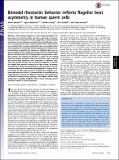Bimodal rheotactic behavior reflects flagellar beat asymmetry in human sperm cells
Author(s)
Bukatin, Anton; Kukhtevich, Igor; Kantsler, Vasily; Stoop, Norbert; Dunkel, Joern
DownloadBukatin-2015-Bimodal rheotactic b.pdf (1.306Mb)
PUBLISHER_POLICY
Publisher Policy
Article is made available in accordance with the publisher's policy and may be subject to US copyright law. Please refer to the publisher's site for terms of use.
Terms of use
Metadata
Show full item recordAbstract
Successful sperm navigation is essential for sexual reproduction, yet we still understand relatively little about how sperm cells are able to adapt their swimming motion in response to chemical and physical cues. This lack of knowledge is owed to the fact that it has been difficult to observe directly the full 3D dynamics of the whip-like flagellum that propels the cell through the fluid. To overcome this deficiency, we apply a new algorithm to reconstruct the 3D beat patterns of human sperm cells in experiments under varying flow conditions. Our analysis reveals that the swimming strokes of human sperm are considerably more complex than previously thought, and that sperm may use their heads as rudders to turn right or left.
Date issued
2015-12Department
Massachusetts Institute of Technology. Department of MathematicsJournal
Proceedings of the National Academy of Sciences
Publisher
National Academy of Sciences (U.S.)
Citation
Bukatin, Anton et al. “Bimodal Rheotactic Behavior Reflects Flagellar Beat Asymmetry in Human Sperm Cells.” Proceedings of the National Academy of Sciences 112.52 (2015): 15904–15909. © 2017 National Academy of Sciences
Version: Final published version
ISSN
0027-8424
1091-6490